Oshima Ocean Salt: Natural Salt Crafted by Sea and Wind
Oct 18,2018
Oshima Ocean Salt: Natural Salt Crafted by Sea and Wind
Oct 18,2018
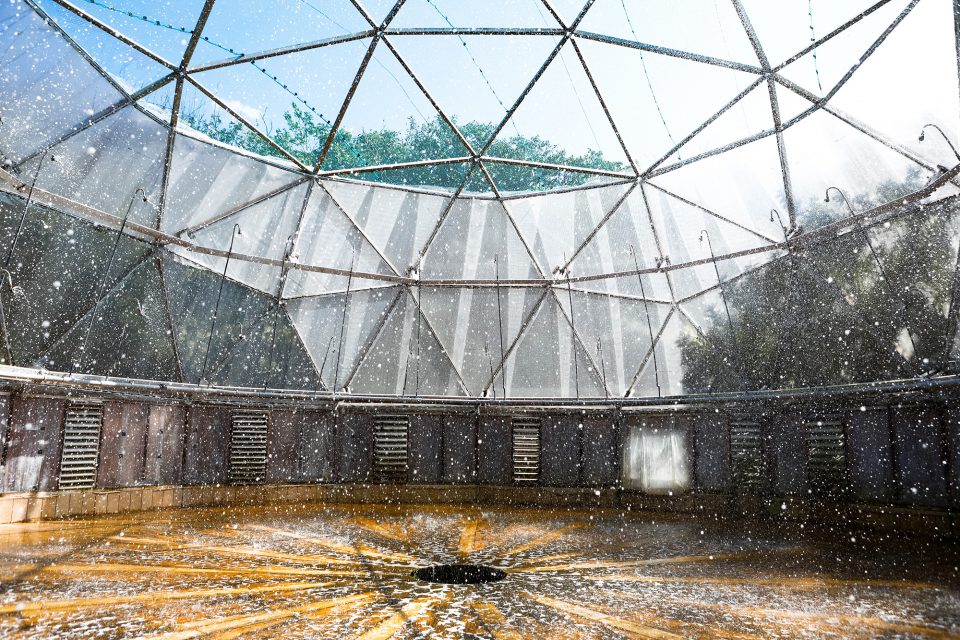

Located about two hours from Tokyo by high-speed jet ferry, the island of Izu Ohshima has no convenience stores, family restaurant chains, or fast-food outlets. You might believe that it’s an inconvenient place with little entertainment or fun, but don’t be fooled. Life on the island is incredibly rich. The island’s delightful culinary wisdom, which harmonizes with nature and takes advantage of the local environment, is still very much alive today. In this series of articles, we will do a deep dive into the food culture of Izu Ohshima and demonstrate just how vibrant and powerful its food products, rooted in the island’s climate and soil, really are.
On our first visit to Izu Ohshima, we happened to come across Ohshima Ocean Salt while eating lunch at Curry House Kiri Kiri, a popular spot among tourists. The salad served with our curry was exceptionally tasty, and we were surprised at the pleasant sensation of our bodies smoothly absorbing the salad. The owner, Kiri, explained why the salad was so delicious. “The vegetables are locally grown organic vegetables. The dressing consists of only salt, olive oil, and lemon. We use natural Ohshima Ocean Salt. This salt is truly amazing.”
On further inquiry, we discovered that the company, in addition to regular salt, also has an exclusive salt made solely from seawater collected on days with a full moon.
This made us even more curious. How do they make their salt? What is special about seawater collected on days with a full moon? How is it different from ordinary salt? Who are the people making this salt? We decided straight away to visit Ohshima Ocean Salt and find out the answers directly from the source.
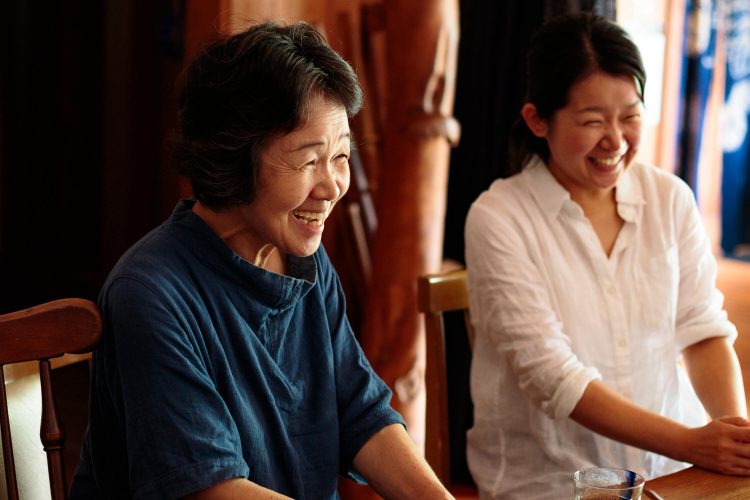
Sakamoto Kyoko (left) and Hiromi, her daughter
Ohshima Ocean Salt is a family-run business and the entire Sakamoto family works together to produce their salt. Our guides were Sakamoto Hiromi, a second-generation salt maker, and her mother, Kyoko. Our eyes were immediately drawn to the salt dome, a uniquely designed misting seawater concentrator with an impressive looking geometric roof. Looking inside the dome, you see seawater pumped up from the ocean spraying from nozzles in all directions and sparkling in the sunlight. As you gaze dreamily at the scene, a fine mist, carried by the wind, occasionally envelops you.
“In the dome, we spray a mist of deep seawater captured from the ocean to expose it to the sun and wind in order to evaporate away the water and concentrate the salt. Relying on the forces of nature, it takes about a month to concentrate 30 kiloliters of seawater down to about five kiloliters.”
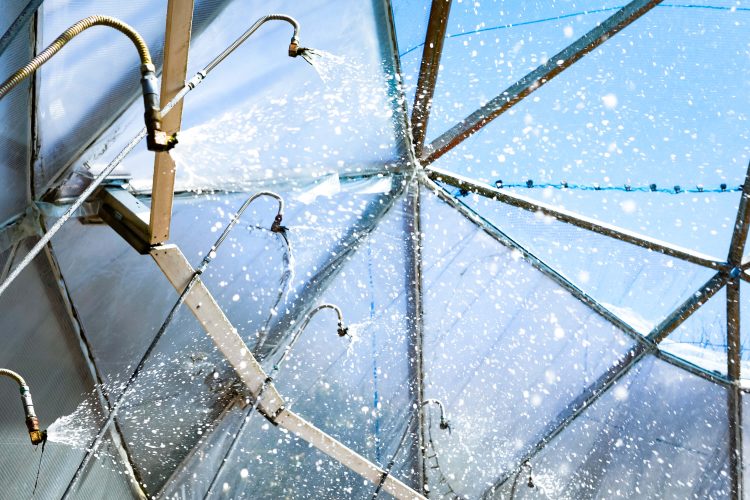
Seawater is sprayed from dozens of nozzles
The concentrated seawater brine is placed in concentration tanks to further evaporate its water content. When it has become more concentrated, it is again transferred to a crystallization kettle, where the concentrate is heated gently causing the salt to slowly crystalize.
“The salt crystals bind together, so that the entire surface of the kettle sparkles with salt crystals. They then accumulate at the bottom of the kettle. This action looks just like a flower blooming.” As Hiromi relates this to us, her own eyes sparkle with excitement. The accumulated salt is slowly cooled and then separated into salt crystals and bittern using a centrifuge. At long last, the salt is finished. Natural salt production is a time-consuming and labor-intensive endeavor.
Because Japan is surrounded by ocean waters, many people believe that finding salt is not an issue for the country. The reality is that because of Japan’s frequent rainfalls, producing salt naturally by drying seawater and extracting salt crystals, as is done in Mexico, Australia, and other countries, is very hard to do here. Moreover, Japan has no rock salt deposits. So surprising as it sounds, Japan is one of the world’s most salt-poor countries.
Before World War II, a salt monopoly system was established for national prosperity and defense, and later, the Salt Monopoly Act was enacted. The government went as far as abolishing salt evaporation ponds that produce salt from seawater. For a time, then, the Salt Monopoly Act effectively banned the production of natural salt from seawater in the country. What replaced natural salt was table salt made with an ion exchange membrane process. This process allows for the mass production of salt regardless of weather conditions, but it also results in the loss of many of the minerals present in seawater.
Natural salt, a mineral essential for life, was about to disappear permanently from Japan if nothing was done. Sakamoto Akihiro, Hiromi’s father and an acupuncturist at the time, felt that natural salt production must not be allowed to die out. So he and the late Tani Katsuhiko, a central figure in the effort to revive natural salt, moved to Izu Ohshima, an island surrounded by beautiful seas, in 1976. This marked the beginning of natural salt production on the island.
Sakamoto’s wife, Kyoko, picks up the story. “I was six months pregnant when we moved to Izu Ohshima. Producing salt through a long process of trial and error was incredibly difficult and exhausting. Despite the hardships though, we were full of hope.” Kyoko was a pillar of support for her husband, who was busy building salt-production equipment, and the volunteers who came from all over the country. She provided homemade bread and meals for the crew, sustaining everyone’s physical and mental well-being.
As natural salt production on Izu Ohshima gained momentum, the first samples of trial production salt were distributed to members, and soon after more and more members, especially homemakers, began seeking out this natural salt produced on Izu Ohshima.
The mineral compositions of amniotic fluid and seawater are said to be quite similar. The disappearance of natural salt from the world seemed to have sparked an instinctive, rather than a rational, desire for natural salt among people, as evidenced by the surge in demand.
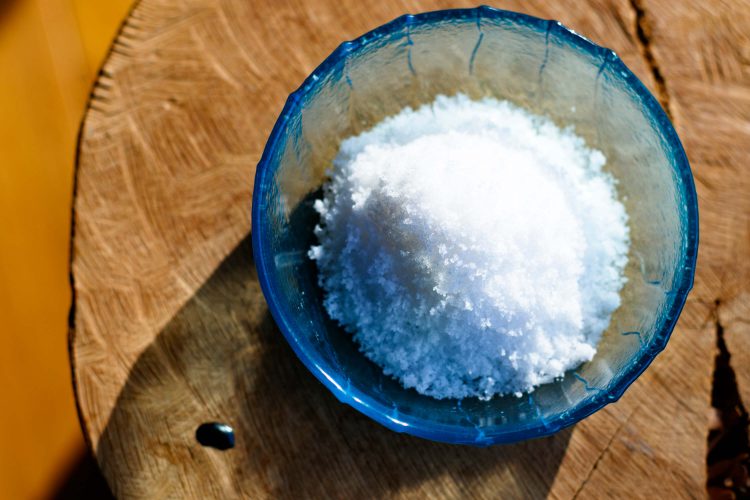
Pure-white natural salt has a mild saltiness
The Salt Monopoly Act was finally abolished in 1997. This allowed Sakamoto to go independent and start producing his own salt. This led to the formation of the current-day Ohshima Ocean Salt firm. Hiromi, who decided to carry on her father’s legacy, continues the grueling work every day with enormous enthusiasm, despite her small frame. The Full Moon Ocean salt, which is produced from deep seawater collected on days with a full moon, came about as a result of Hiromi having a child.
“I gave birth to my son at home on Izu Ohshima. The midwife who came to assist with the delivery told me: ‘I’ve witnessed many births, and I feel that childbirth is definitely influenced by the full moon. It would be interesting to have salt that was also made on the day of a full moon.’ After hearing about this, my father began making salt with seawater collected on days with a full moon.”
People say that salt produced under a full moon has an extra level of deliciousness compared with salt produced with seawater collected on an ordinary day.

The bittern created from full-moon seawater has a strong reddish hue
On tasting Full Moon Ocean salt, you can sense a faint umami flavor similar to dashi stock. If you’ve ever licked the seawater on your hands or arms after swimming in the ocean, you’ll understand. That’s because seawater is salty, but it is also somehow delicious. With Full Moon Ocean salt, it’s unmistakable that the salt was produced from the sea. It has a natural umami that you don’t get with chemical salts. What’s even more mysterious is that the bittern created from seawater collected on days with a full moon has a strong reddish hue. The difference is striking when compared with the pale yellow of bittern made from seawater collected on other days. One can imagine that even the same seawater changes with the rhythms of nature.
Umi no Kaori [Scent of the Sea] is another mystical product made by skimming off the top clear layer of highly concentrated bittern. Because the liquid is made from bittern, it naturally has a bitter taste. But apparently if your body is mineral deprived, you won’t notice the bitterness.
“Producing salt is physically demanding”, says Hiromi. “When we’re really fatigued, my mother will bring some tea with Umi no Kaori. Just seeing her presence during breaks makes everyone smile, as if a goddess has arrived.” When you add a few drops of Umi no Kaori in some water and drink it, the body smoothly absorbs it, much like water at a hot springs. After a few moments, you can feel your body become warmer. A feeling of relaxation softly fills your body.
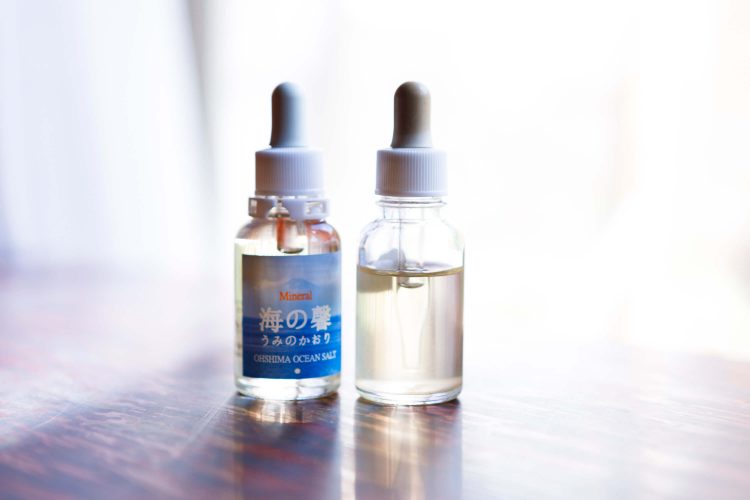
Umi no Kaori is an important part of the Sakamoto family’s health management regime. The correct amount is when you can just start to sense its deliciousness.
“We make soy sauce at home using pesticide-free soybeans and wheat, soy sauce koji mold, water from Izu Ohshima, and our own natural salt. The late Hagiwara Shigetada, who studied soy-sauce making, developed this method so that farmers’ wives could make delicious soy sauce more readily. The soy sauce ages while soaking up plenty of sunlight.”
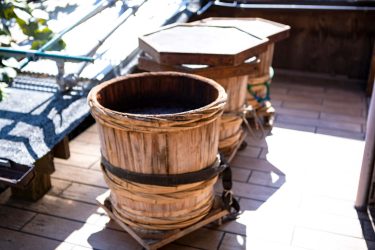
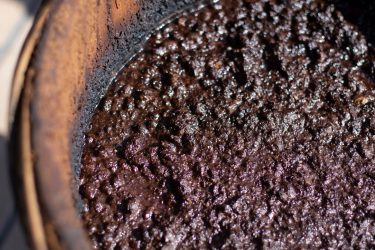
Soy sauce ferments under the sun. A pleasant aroma fills the air.
The soy sauce barrels lined up on the Sakamoto’s back deck appear to be almost basking in the sun. Occasionally, the wind carries the fragrant aroma of soy sauce through the air. We were told to keep the soy sauce in the refrigerator as the fermenting bacteria are alive. The homemade soy sauce we received, like the salt, has a mild, mellow flavor.
When people say to reduce your salt intake for your health, they are referring to chemical salt. Natural salt, which is rich in minerals, energizes and revives the body. Popular in the Sakamoto home is a simple pumpkin or corn potage soup seasoned with only salt. Sprinkling a bit of salt on tempura brings out the sweetness of the ingredients, and vegetable salads seasoned with salt alone have a rich, concentrated flavor. And a clear soup made by adding local seaweed and salt to a bowl of hot water, without any stock, provides a deep, comforting flavor.
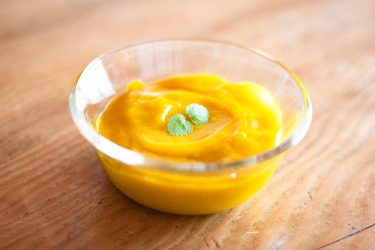
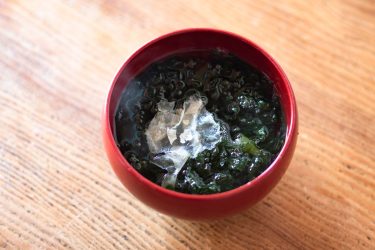
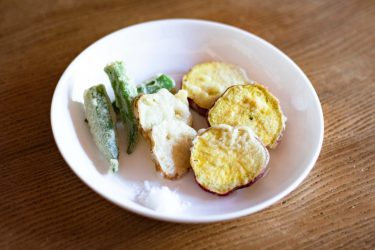
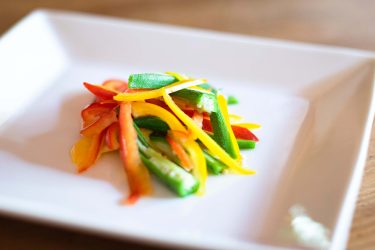
Just the addition of salt makes these dishes delicious. That is the power of natural salt.
Izu Ohshima is the place that changed the history of Japan’s salt production. The perseverance of Sakamoto and his associates, who lived side by side with salt, is why salt with the gentle flavor of the sea is still with us today. Salt production will continue now and in the future, blessed by sunlight, blown by the wind, and driven by a single-minded generosity.
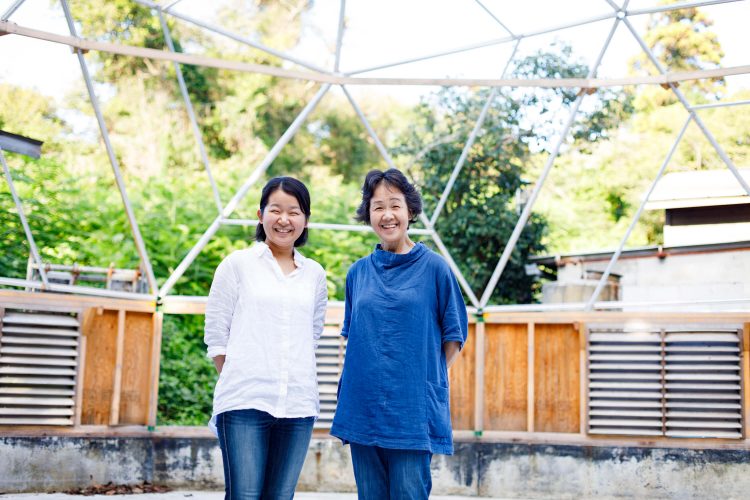
At the original salt dome that is currently under repair. Sakamoto Akihiro, Hiromi’s father and the first-generation salt maker, was hospitalized at the time of our visit due to an injury sustained during the repairs. We look forward to hearing his stories someday.
▶What Is Kusaya? Discover the Fermented Power of Kusaya Brine
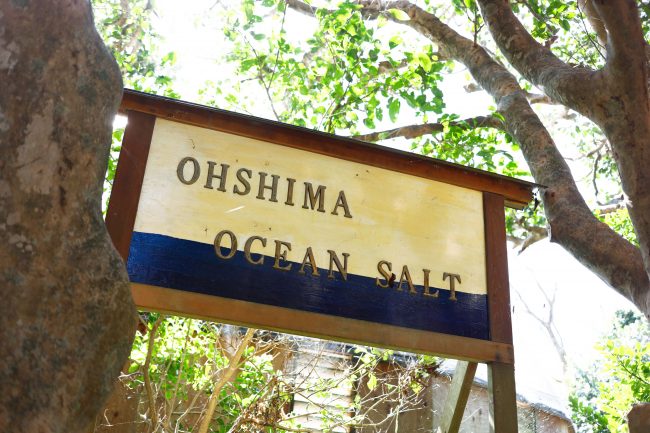
Factory tours are available by reservation (2,000 yen per person, including a storytelling session and a gift of a 200-gram package of Flower Of Ocean salt)
●Getting to Izu Ohshima
Getting to Izu Ohshima takes an hour and 45 minutes by high-speed jet ferry or six hours by overnight ferry from Tokyo’s Takeshiba Sanbashi Pier. There are also ferry services from Kurihama Port in Kanagawa and Atami Port and Ito Port in Shizuoka.
Contact Tokai Kisen at 03-5472-9999 or 0570-005710
URL:https://www.tokaikisen.co.jp/